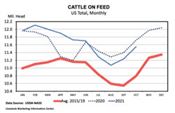USDA Cattle Report Reflects Declining Feedlot Inventories
LITTLE ROCK, ARK.
For the fourth month in a row, cattle feedlot inventories across the United States fell below same-month figures from 2020, according to a recent report from the U.S. Department of Agriculture.
The Oct. 22 October Cattle on Feed Report described a 1.4 percent decline in inventories from feedlots with a capacity of 1,000 head or more, totaling about 11.6 million cattle.
James Mitchell, assistant professor of livestock marketing and management for the University of Arkansas System Division of Agriculture, said that while overall feedlot numbers are still gradually improving from 2019, the market forces at work are moving more slowly than producers and consumers might hope.
“The placement data continues to provide critical insights for our fall calf market and future beef production,” Mitchell said in a recent report of the cattle market.
Mitchell said three factors have contributed to year-over-year declines in feedlot placements.
“First, 2020 was the highest September placement since 2011, reflecting the pandemic-related disruptions to feedlot placements earlier that year,” Mitchell said. “Second, drought pressure across the country likely forced some cattle into feedlots earlier than anticipated.
“Seasonally, we would expect an increase in placements of heavier feeder cattle in September compared to August,” he said. “This year, it appears that the seasonal peak in feeder cattle placements occurred one month earlier than normal seasonal dynamics might predict.”
Finally, Mitchell said, calf crops have declined for three consecutive years, based on July data.
“It will become more apparent that we have tighter feeder cattle supplies as we move into 2022,” he said. “Feed costs will also impact the relative value of cattle in different weight classes.”
Shane Gadberry, professor of ruminant nutrition for the Division of Agriculture, said that U.S. consumers have certainly seen an increase in meat prices at the grocery store over the past year, although “ higher meat prices have more to do with processing and distribution challenges than cattle supply right now.”
“The hint of future tighter supplies from reduced beef cow inventories may help calf value for the next few upcoming calf crops,” Gadberry said. “In the meantime, input costs are going to put additional strain on returns.”
“Meat prices are not unique in this story,” Mitchell said. “They are part of a broader discussion about food price inflation. Year-over- year, we've seen a 5.4 percent increase in the all-items Consumer Price Index, which is one measure of economy-wide inflation. Food prices are leading the charge with a 4.6 percent year-over-year increase.”
Both Mitchell and Gadberry said that a strong cattle futures contract market is providing an incentive for producers to keep their cattle over the winter, rather than sell them for slaughter in the short term, although this, in part, depends on the availability of winter forage.
“With high feed costs, feeders are going to like placing heavier cattle in feedlots. So, there is some incentive for cow-calf producers to try to manage for extra forage for growing weaned calves.
Monitoring input costs and reducing production wastes remain important to cow-calf profitability.” ∆

For the fourth month in a row, cattle feedlot inventories across the United States fell below same-month figures from 2020, according to a recent report from the U.S. Department of Agriculture. The Oct. 22 October Cattle on Feed Report described a 1.4 percent decline in inventories from feedlots with a capacity of 1,000 head or more, totaling about 11.6 million cattle.
Division of Agriculture graphic